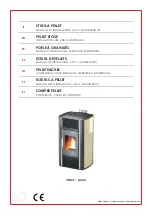
LIGHTING
Before lighting the stove check with the installer that
the installation work and commissioning checks
described previously have been carried out correct-
ly and that the chimney has been swept clean, is
sound and free from any obstructions. As part of the
stoves commissioning and handover the installer
should demonstrate how to operate the stove cor-
rectly.
LEAVE THE DOOR SLIGHTLY AJAR DURING
THE FIRST FIRING TO PREVENT THE ROPE
FROM STICKING TO THE PAINT DURING THE
CURING PROCESS.
LIGHTING THE STOVE
NOTE: When operating the stove, it is recommend-
ed to use the Glove provided to open the
fire door as the door handle will become
hot.
1.
Open the fire door and open the primary air
control by pulling it fully out.
2.
Open the secondary air inlet by pulling the
control fully out.
3.
Cover the grate with crumpled pieces of
paper and lay 10-12 pieces of kindling on top
of the paper towards the back of the firebox.
4.
lgnite and close the fire door.
5.
When the kindling is well alight open the fire
door and add more kindling of a larger size
to sustain the fire. Close the fire door.
6.
When a hot fire bed is established add the
normal fuel.
7.
When well lighted, adjust the air controls as
required for the heat output required (see
Table below). Both controls should be adjust
ed in conjunction with each other to get the
appropriate burn rate with exact settings on
each control depending on the draught
conditions of the chimney to which the unit is
connected.
REFUELLING
Before opening the door, open the primary air con-
trol fully as this will help to eliminate any smoke or
fly ash resident in the combustion chamber. Add fuel
to fire, close fire door and adjust the primary air con-
trol to the desired position.
SLOW BURNING
Slow burning will cause the window glass to blacken
and should not be used for a long period. It should
only be done after the fire has been established and
been running at nominal output for a period of time.
For a prolonged slow burn, fill the firebox of fuel up
to a maximum height just below the top of the fire
fence at the front of the door opening. Push the pri-
mary air control knob in to close the primary air to
the minimum setting and push the secondary air
control in to set the secondary air to the minimum
setting.
DISPOSAL OF ASHES
Your stove is provided with an ashpan. This ashpan
should be emptied every day. If ashes are allowed to
build to grate level you could damage the grate by
overheating. We recommend that you remove ashes
after you have riddled the fire when the stove is thor-
oughly cooled. Ashes should be placed in a metal or
other non-combustible container with a tight fitting
lid. The closed container of ashes should be placed
on a non-combustible material, pending final dispos-
al. If ashes are buried in soil, or otherwise dumped
they should be retained in the closed container until
they are thoroughly cooled.
Open the firedoor and remove the ashpan using the
tool provided, see Fig 11. Close the firedoor. When
the ash is disposed of replace the ashpan.
12
Fuel
Primary Air
Secondary Air
Wood
Max Opening of 50% Adjust to Desired
Setting
WARNING:
DO
NOT
LEAVE
BOTH
AIR
CONTROLS FULLY OPEN AS THIS
CAN CAUSE THE STOVE TO
OVERHEAT,
DAMAGING
THE
INTERNAL COMPONENTS.
Fig.11
Ashpan


































